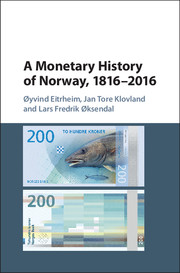Book contents
- Frontmatter
- Contents
- List of Figures
- List of Tables
- Preface
- 1 A Monetary History in Five Parts
- PART I THE LONG PROMISE, 1816–1850
- PART II THE RISE OF PRIVATE DEPOSIT-TAKING BANKS, 1850–1914
- PART III WORLDWAR I AND TURBULENT INTERWAR YEARS, 1914–1940
- PART IV MONEY IN TIMES OFWAR, CENTRAL PLANNING AND REGULATION, 1940–1986
- PART V THE LONG RETURN, 1986–2016
- Bibliography
- Index
PART III - WORLDWAR I AND TURBULENT INTERWAR YEARS, 1914–1940
Published online by Cambridge University Press: 09 February 2017
- Frontmatter
- Contents
- List of Figures
- List of Tables
- Preface
- 1 A Monetary History in Five Parts
- PART I THE LONG PROMISE, 1816–1850
- PART II THE RISE OF PRIVATE DEPOSIT-TAKING BANKS, 1850–1914
- PART III WORLDWAR I AND TURBULENT INTERWAR YEARS, 1914–1940
- PART IV MONEY IN TIMES OFWAR, CENTRAL PLANNING AND REGULATION, 1940–1986
- PART V THE LONG RETURN, 1986–2016
- Bibliography
- Index
Summary
The world as it was ended in 1914. The Great War came to unleash forces along a broad front that ultimately undermined the fundamentals on which the prewar society rested. One of the casualties of the war was an international monetary regime based on gold that linked national currencies together in a fixed exchange rate system. The attempts to restore the regime in the 1920s eventually proved futile. By the early 1930s, economic nationalism was on the rise and the few countries still on gold defended their currencies through capital controls and trade restrictions. Only after 1945, reflecting the lessons of the interwar years, was a new viable international monetary regime back in force.
The interwar years were not only the decades between the wars but, just as important, the time between two long periods of extraordinary stability. Relative to what came before and after, the interwar years stand out as a period of sluggish growth, large economic fluctuations, social unrest and political instability. For economic thinking it was a period of nascent transformation. Economic liberalism no longer seemed to give answers to the new problems arising from the war and its aftermath, giving way to a search for new answers across the political spectrum. These answers more often than not included an enhanced role for the government, a turn against market forces and a new trust in the prospects of planning. The origins of the post-1945 political order centred on quantitatively oriented demand management and government planning can be found in these endeavours.
Norway was caught up in this maelstrom. Although able to maintain its neutrality, Norway could escape neither the economic consequences of war nor its geopolitical position. The war created a dual Norway. On the one hand, a strong increase in the demand for export goods and particularly shipping services created a substantial inflow of foreign exchange and booming conditions in many industries. Enhanced expectations led to a pronounced jobbing atmosphere centred on the stock market, new shipping enterprises and the financial sector.
- Type
- Chapter
- Information
- A Monetary History of Norway, 1816–2016 , pp. 259 - 262Publisher: Cambridge University PressPrint publication year: 2016

